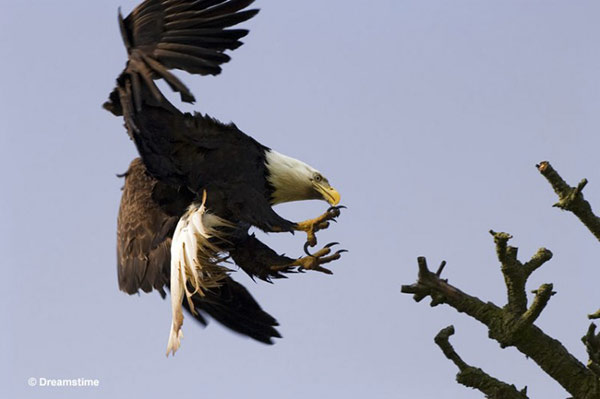The Bald Eagle is known to most people. Even if you haven’t seen one, it’s impossible not to know their history and cultural symbolism.
We find this conspicuous bird in forests and big trees next to rivers, lakes, coastlines, and other wetland habitats. Bald Eagles are often seen soaring over and perching near waterways.
Much to the delight of birders, at some special sites, dozens of wintering Bald Eagles can congregate to feed on fish and pose for the camera!
On this page
Identification
The adult Bale Eagle is pretty easy to identify. This large raptor is much bigger than any Red-tailed Hawk or Turkey Vulture, and has a dark brown body, and a white head, rump, and tail.
Adult birds also have a big, yellow hooked beak, pale eyes, and yellow legs and feet with long, black talons. Although both sexes look the same, as with many other raptor species, female Bald Eagles are bigger than males.
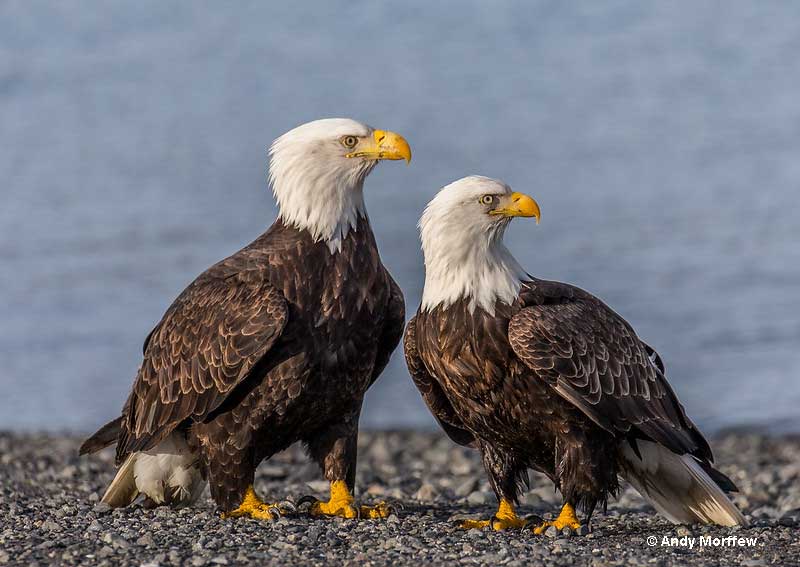
Judging by the size, female is on the left and male is on the right. Photograph © Andy Morffew
On average, females weigh 11.79 pounds, whereas males weigh 9.32. The average length of the Bald Eagle is 31 inches and the average wingspan is 80 inches (more than six and a half feet!).
Keep reading: How big are Bald Eagles compared to humans and other birds?
Juvenile Bald Eagles can be trickier to identify. One-year-old eagles have dark mottled brown plumage with some white markings in their tail, and some white on their underwings. They also have a big, blackish beak with some yellow on its base.
Over the next couple of years, young Bald Eagles show more white in their tail and body, and, by the age of three, start to show some white on their head.
No matter what their age, Bald Eagles fly with deep wing flaps and soar on “flat,” long, broad wings.
They make piping whistled calls, “kick kipkikikip.”
Food
Bald Eagles mostly feed on fish. However, depending on where they live and what food is available, they also feed on mammals, aquatic birds, and carrion.
This large raptor eats a wide variety of fish species including shad, salmon, and just about any other species that comes to the surface of the water. It catches live fish by soaring or watching from a perch, flying down, and then snatching the fish with its talons.

Juvenile Bald Eagle enjoying a snack.
Bald Eagles also typically take advantage of situations that provide lots of easy fishing opportunities. For example, they prefer shallow areas with spawning salmon, water that has fish stunned or killed by hydro turbines, and other similar situations.
This species also commonly steals food from other Bald Eagles, gulls, and other waterbirds. They won’t hesitate to eat carrion including fish, deer, and other mammals, and also prey on ducks, geese, and herons.
Although Bald Eagles take some mammals and waterbirds while breeding, they tend to prey more on ducks, coots, and geese in the winter. To catch them, a pair of eagles can work together or one will quickly swoop down to snatch a bird from the water, or catch it in flight.
Nesting and Eggs
The Bald Eagle builds a big, bulky nest out of large sticks, moss, and some other green foliage. Their nests can be huge and are often six feet wide and five feet tall! Both sexes help build it in a big tree in or next to a wetland.
They can nest in a wide variety of trees and even on cliffs but prefer live trees big enough to support their large, heavy nests. An ideal nesting tree also has an excellent view of their surroundings and is near other trees where the eagles can perch.
Related: Do eagles mate for life?
A pair of Bald Eagles can use the same nest year after year, adding onto it with each nesting season. The female usually lays two dull white eggs that are 2.7 inches long, and weigh 4.23 ounces.
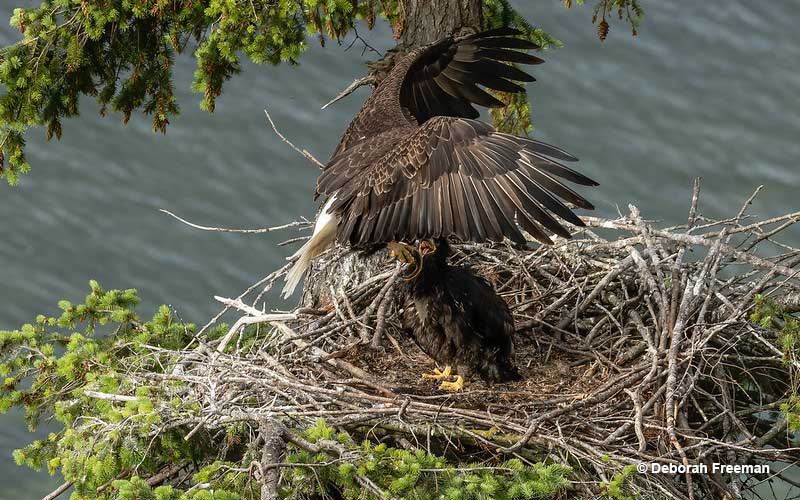
Although the female does most of the incubating, the male also helps. After 35 days, the eggs hatch and the young eagles are fed by both parents in their nest for 8 to 14 weeks. When they leave the nest, the young birds stay in the area and continue to be fed by the adults for six more weeks.
At that time, the young eagles hunt a lot more on their own and leave their nesting area when they are 17 to 24 weeks old.
Current Situation
The Bald Eagle frequents a wide variety of wetlands in much of Canada, Alaska, and the lower 48 states. As long as enough food and nesting sites are present, this impressive bird can even live in wetlands within urban areas.
In winter, flocks can gather at hydro plants and other ice-free wetlands at many sites in the lower 48 states.
The Bald Eagle is listed as Least Concern in the IUCN Red List, although in Ontario, Canada, it is a species of special concern.
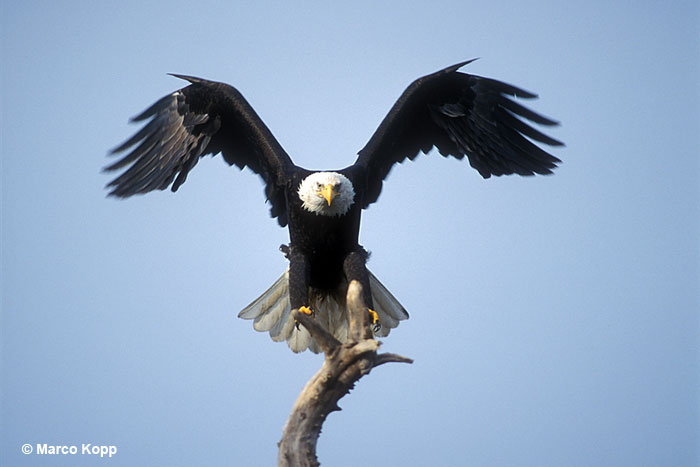
Bald Eagles are not currently endangered but this wasn’t always the case. During the first half of the 20th century, this species was endangered in most of the lower 48 states and was also heavily persecuted in Alaska.
Related: What is a group of eagles called?
Many Bald Eagles were killed because they were believed to be a threat to livestock and salmon populations. Eggshell thinning caused by DDT and other pollutants also greatly contributed to their decline.
However, after DDT was prohibited and Bald Eagles were protected, this species steadily grew in numbers to once again become a common bird.
Bald Eagle Facts
- Bald Eagles build a truly massive nest. Their big, bulky nests grow as pairs reuse and add more sticks to their previous nest. The largest nest ever recorded was one in Florida that was nearly 9 feet across and 21 feet tall!
- This species often decorates its nest with a few plastic bottles, duck decoys, or other odds and ends. It is believed to do this to show that the nest is in use.
- The Bald Eagle has been the official national bird for the USA since 1782. This majestic raptor has also played important, sacred roles in Native American cultures for thousands of years.
- Bald Eagle, along with the American Flag, are national symbols that everyone in the world knows.
- Bald Eagles can spot a fish a mile away! Their eyesight is eight times better than a person with 20 x 20 vision.
- The talons of the Bald Eagle can grasp prey with a force of 400 psi. This is much stronger than the strongest grip of any person and helps them clutch and kill fish and other prey.
- Bald Eagles serve as an inspiration to many. They have even made their way onto sports fields in the form of Philadelphia Eagles.
Similar Species
The Bald Eagle is pretty easy to recognize. However, it might be confused with a few other bird species.
Golden Eagle
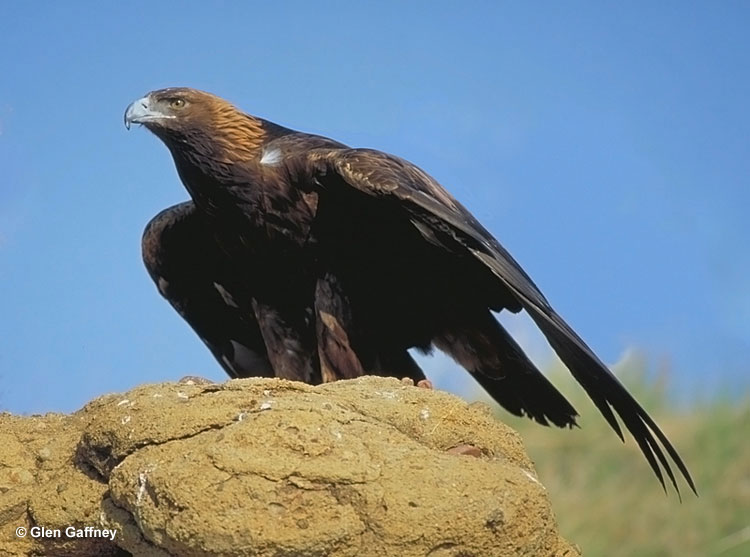
The Golden Eagle is around the same size as the Bald Eagle and can look pretty similar. Although adult Bald Eagles are unmistakable, young birds can resemble Golden Eagles.
However, Golden Eagles soar with wings held in a shallow “V” and have a pale brown head. They can also have brown plumage mottled with pale brown but never have mottled white feathers on their body, nor on the inner parts of their wings.
Related: Golden Eagle vs Bald Eagle
Crested Carcara
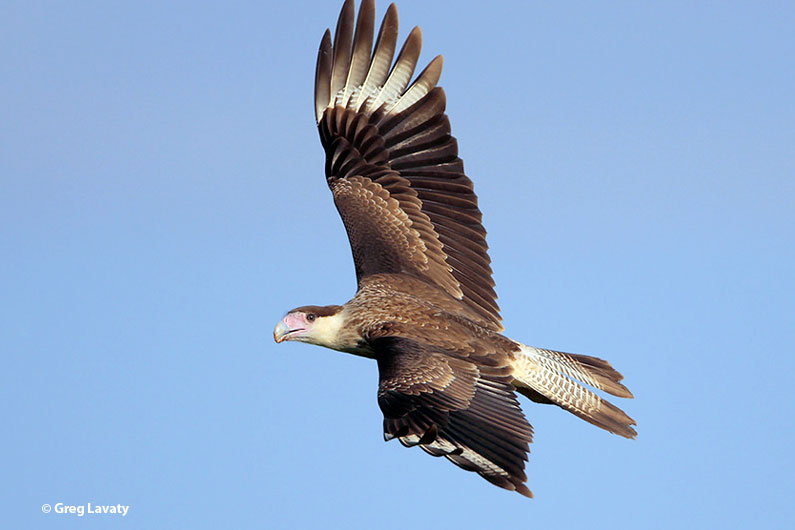
In Florida and Texas, Crested Carcara with a pale head and tail is sometimes confused with the Bald Eagle.
However, it is not nearly as big, has an orange face, black cap, black tip on its tail, and white patches at the tips of its wings.
Osprey
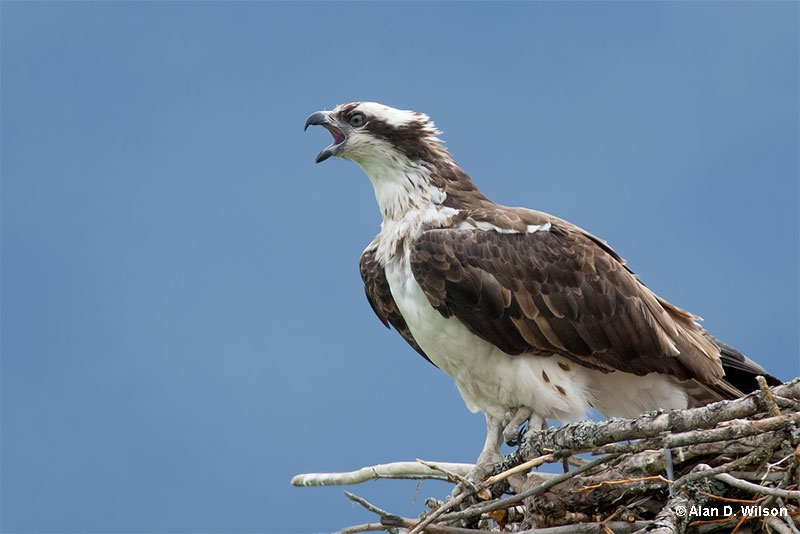
Usually found near water, Ospreys have a dark line through the head, not the complete white head of the Bald Eagle.
Osprey lack the white tail of the adult Bald Eagle. They fly with a bent wing, compared to the straight wing of the Bald Eagle.
Learn more: Osprey vs eagle
Frequently Asked Questions
Why is the Bald Eagle so special?
The Bald Eagle is special because it has been an official symbol of the USA since 1782, and a sacred animal for Native American tribes for much longer. It only lives in North America, is one of our largest raptors, and has a majestic, powerful appearance.
Why do they call it a Bald Eagle if it’s not bald?
They call it a Bald Eagle even though it’s not bald because, in this case, the word “bald” refers to “piebald”. This is an old word to describe an animal with contrasting, dark and light colors.
How smart is a Bald Eagle?
A Bald Eagle is a pretty smart bird. Although they don’t seem to be as smart as crows, they have to be smart enough to figure out how to catch prey in many situations. To reach fish, they can break ice with their beaks, work together to catch ducks, and sometimes play with each other by passing sticks to each other in flight!
What states are Bald Eagle found in?
The Bald Eagle is found in every state except for Hawaii. It is especially common in Alaska, Florida, and Washington.
Can a Bald Eagle hurt a human?
A Bald Eagle is capable of hurting someone climbing to its nest but they don’t attack people in other situations.

